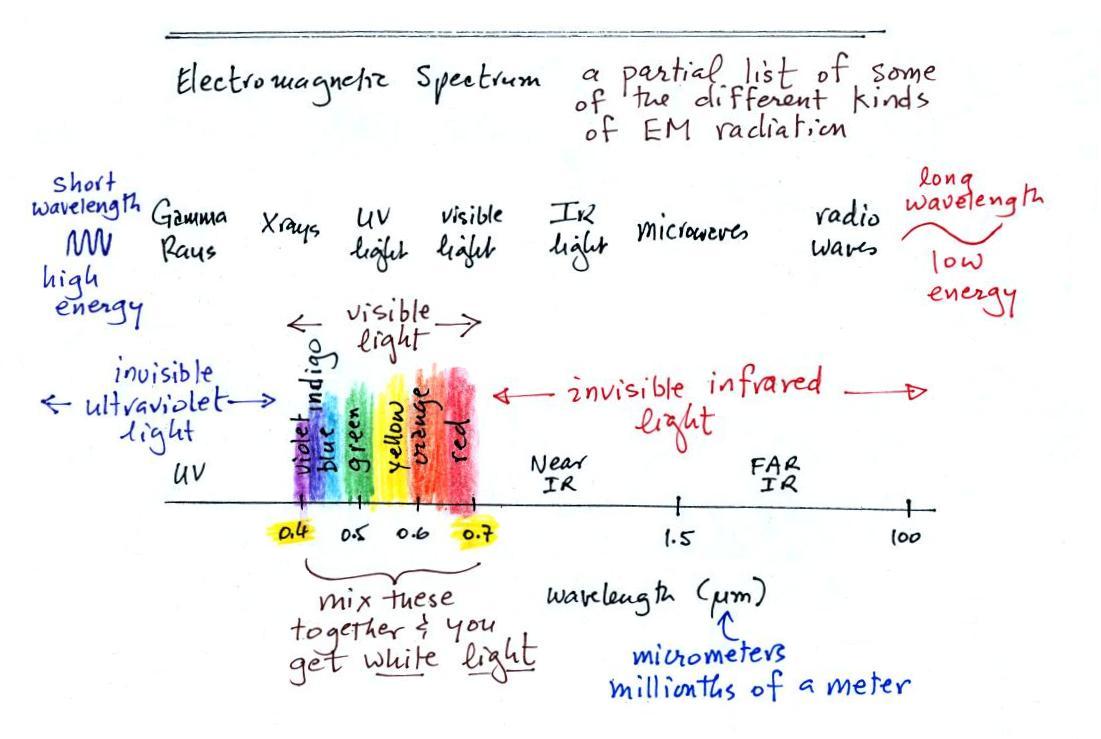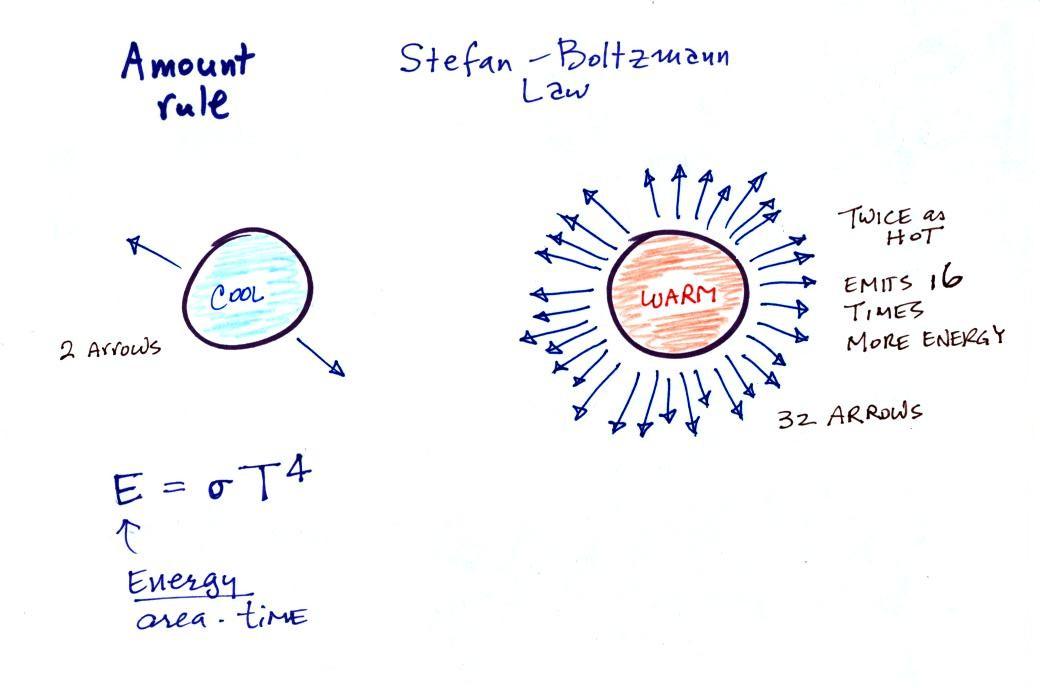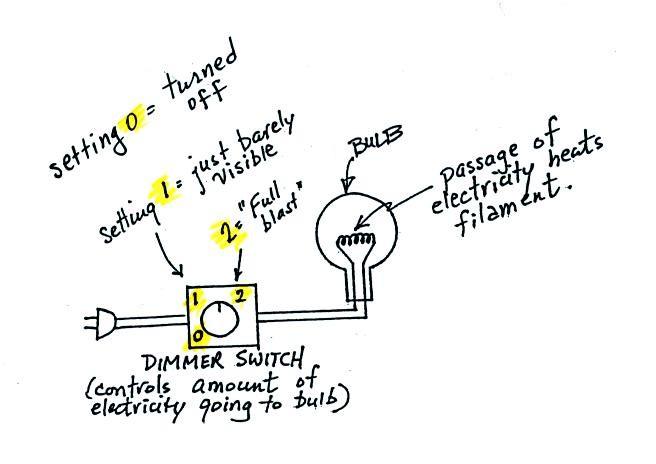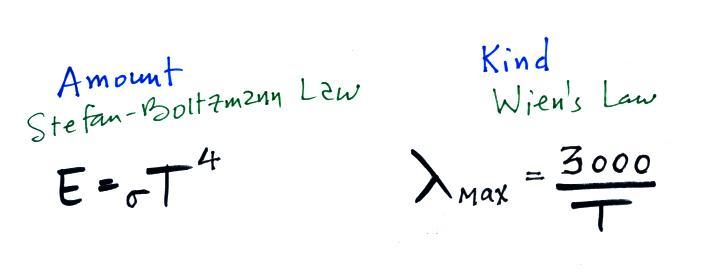Tuesday Oct. 9, 2012
click here to
download today's notes in a more printer friendly format
I had planned on playing two songs before class, "Hold
On" and "Baka"
from
a
group named Outback.
In the end we only had time for the first one.
The Upper Level Charts Assignment has been graded. If
you lost 3
pts or less on the assignment you earned a Green Card. Everyone
that turned in an assigment earned 0.5 pts of extra credit.
I didn't mention it but most of the last of the 1S1P Assignment #1
reports (the radon topic) has been
graded and was returned in class. My TA brought by the remaining
pile of papers after class so I'll have everything with me in class on
Friday.
The final version of the Quiz
#2
Study Guide
is now online.
This is really just a partial list
of some of the different
types of EM
radiation. In the top list, shortwave length and high energy
forms of EM radiation are on the left (gamma rays and X-rays for
example). Microwaves and radiowaves are longer wavelength, lower
energy forms of EM radiation.
We will mostly be concerned with just ultraviolet light (UV),
visible
light (VIS), and infrared light (IR). Note the micrometer
(millionths of a meter) units used for wavelength for these kinds of
light. The visible
portion of the spectrum falls between 0.4 and 0.7 micrometers.
UV and
IR light are both invisible. All of the vivid colors
shown above
are just EM radiation with slightly different wavelengths. When
you see all of these colors mixed together, you see white light.
The world would not look the same if we were able to see IR
light instead of visible light
The picture at left was taken using normal film, film that is
sensitive to visible light. The picture at right used infrared
film. In both pictures we are looking at sunlight that strikes
the tree or the ground and is reflected toward the camera where it can
be photographed (i.e. these aren't photographs of light emitted by the
tree or the ground). The tree at left is green and relatively
dark (it reflects green light but absorbs the other colors of visible
light). The tree at right and the ground are white, almost like
they were covered with snow. The tree and grass on the ground are
reflecting infrared light. Here are many
more
images taken with infrared film.
Here's another example, photographs of the
ground taken from an
air plane using ordinary film at left
(responds to visible light) and infrared film at
right. Notice how the IR photograph is able to "see through"
the
haze. The haze at left is scattered light. IR light is not
scattered as readily as visible light.
Here are some rules governing the
emission of electromagnetic
radiation:
1.
Unless an object
is very cold (0
K) it will emit EM
radiation. Everything in the classroom: the people, the
furniture, the walls and the floor, even the air, are emitting EM
radiation. Often
this radiation
will be invisible so that we can't see it and weak enough that we can't
feel it (or perhaps because it is always there we've grown accustomed
to it and ignore it). Both the amount and kind (wavelength) of
the emitted
radiation depend on the object's temperature.
2.
The second rule
allows you to
determine the amount of EM radiation (radiant energy) an object will
emit. Don't worry about the units,
you can think of this as amount, or rate, or intensity.
Don't worry about σ (the Greek character
rho) either, it is just a
constant. The amount depends on temperature to
the fourth
power. If the temperature of an object doubles the amount of
energy emitted will increase by a factor of 2 to the 4th power
(that's 2 x 2 x 2 x 2 = 16). A hot object just doesn't emit a
little more energy than a
cold object it emits a lot more energy than a cold object. This
is illustrated in the following figure:
The cool object is emitting 2
arrows worth of energy. The
warmer object is 2 times warmer and is emitting 32 arrows (16 times
more energy).
3.
The third rule
tells you something
about the kind of radiation emitted
by an object. We will see that objects usually emit radiation at
many different wavelengths but not in equal amounts. But, objects
emit
more of one particular wavelength than any of the others. This is
called λmax ("lambda max", lambda is the
greek character used to
represent wavelength) and is the wavelength of maximum
emission. The third rule allows
you to calculate λmax.
The
tendency
for
warm
objects
to
emit
radiation at shorter wavelengths is shown below.

The cool
object is probably
emitting
infrared light so the 2 arrows of energy are colored red. The
warmer object will also emit IR light but also shorter
wavelengths such as yellow, green, blue, and violet (maybe even some UV
if it's warm enough).
If the cool object were warm enough to be emitting a
little visible light it would
probably appear red or orange. In that case the warmer object
would emit some of the shorter wavelengths of visible light and would
probably appear white.
The graphs at the bottom of p. 65 in the photocopied
ClassNotes also help to
illustrate the Stefan-Boltzmann law
and Wien's laws. We're really beating this topic to death.
1.
Notice first
that both and warm
and
the cold objects emit radiation
over a range of wavelengths (the curves above are like quiz scores, not
everyone gets the same score, there is a distribution of grades).
The warm object emits all the wavelengths the cooler object does plus
lots of additional shorter wavelengths.
2.
The peak of each
curve is λmax. Note
that λmax has
shifted toward
shorter wavelengths for the warmer
object. This is Wien's law in action. The warmer object is
emitting lots of types of short wavelength radiation that the colder
object
doesn't emit.
3.
The area under
the warm object
curve is much bigger than the area under
the cold object curve. The area under the curve is a measure of
the total radiant energy emitted by the object. This illustrates
the fact that the warmer object emits a lot more radiant energy than
the colder object.
And for even more reinforcement, a
demonstration.
It consisted of an
ordinary 200 W tungsten bulb is connected to a dimmer switch (see p. 66
in the photocopied
ClassNotes). We'll be looking at the EM radiation emitted by the
bulb
filament.
The graph at the bottom of p. 66 has been split up into 3 parts
and
redrawn for improved clarity.

We start with the bulb turned off (Setting 0).
The
filament will be at room temperature which we will assume is around 300
K (remember that is a reasonable and easy to remember value for the
average temperature of the earth's surface). The bulb will be
emitting radiation, it's shown on the top graph above. The
radiation is very weak so we
can't
feel it. The wavelength of peak emission is 10
micrometers which is long wavelength, far IR radiation so
we
can't see it.
Next we use the dimmer switch to just barely turn the bulb on (the
temperature of the filament is now about 900 K).
The bulb wasn't very bright at all and had an orange color. This
is curve 1, the middle figure. Note the far left end of the
emission curve has
moved left of the 0.7 micrometer mark - into the visible portion of the
spectrum. That is what you were able to see, just the small
fraction of
the radiation emitted by the bulb that is visible light (but just
long wavelength red and orange light). Most of the radiation
emitted by the bulb is to the right of the 0.7 micrometer mark and is
invisible IR radiation (it is strong enough now that you could feel it
if you put your hand next to the bulb).
Finally we turn on the bulb completely (it was a 200 Watt bulb so
it
got
pretty bright). The filament temperature
is now about 3000K. The bulb is emitting a lot more visible
light, all the colors, though not all in equal amounts. The
mixture of the colors produces a "warm
white" light. It is warm because it is a mixture that contains a
lot more red, orange, and yellow than blue, green, and violet
light. It is interesting that most of the radiation emitted by
the bulb is still in the IR portion of the spectrum (lambda max is 1
micrometer). This is
invisible light. A tungsten bulb like this is not especially
efficient, at least not as a source of visible light.
You were able to use one of the diffraction gratings
handed out in class to
separate the
white light produced by the bulb into its separate colors.
When you looked at the bright white bulb filament through one of
the
diffraction gratings the colors were smeared out to the right and left
as shown below.

Some of the gratings handed out in
class behaved a little
differently
and spread out the colors horizontally, vertically, and diagonally.
Here's another infrared photograph that I didn't discuss in class
- a thermal
image
of
a
house. These are photograps of infrared light that
is being emitted (not reflected light) by a house. Remember that
the amount of energy emitted by an object depends strongly on
temperature (temperature to the 4th power in the Stefan-Boltzmann
law). Thus it is possible to see hot spots that emit a lot of
energy and appear "bright" and colds spots. Photographs like
these are often used to perform an "energy audit" on a home, i.e. to
find spots where energy is being lost. Once you locate one of
these hot spots you can add insulation and reduce the energy loss.
Here are the rules for the amount and kind (wavelength of peak
emission) of radiation emitted by an object.
Let's look at the light emitted by
the sun and the earth.
The curve on the left is for the sun. We have used Wien's
law and a temperature of 6000 K to calculate λmax
and got
0.5 micrometers. This is green light; the sun emits more green
light than any other kind of
light. The sun doesn't appear green because it is also emitting
lesser amounts of violet, blue, yellow, orange, and red - together this
mix of
colors appears white. 44% of the radiation emitted by the sun is
visible light, Very nearly half of sunlight (49%) is IR light
(37% near IR + 12% far IR). 7% of sunlight is ultraviolet
light. More than half of the light emitted by the
sun (the IR and UV light) is invisible.
100% of the light emitted by the earth (temperature = 300 K) is
invisible IR light. The
wavelength of peak emission for the earth is 10 micrometers.
Because the sun (surface of the
sun) is 20 times hotter than the earth the sun's
surface emits energy at a much higher rate than the earth. Note
the
vertical
scale
on
the
earth
curve
is
different
than
on
the
sun
graph.
If both the earth and sun were plotted with the same
vertical scale, the earth curve would be too small to be seen.
In the earlier demonstration we learned that
ordinary tungsten bulbs (incandescent
bulbs) produce a lot of
wasted energy. This is because they emit a lot of invisible
infrared light that doesn't light up a room (it will warm up a room but
there are better ways of doing that). The light that they do
produce is a warm white color (tungsten bulbs emit lots of orange, red,
and yellow light and not much blue, green or violet).
Energy
efficient
compact
fluorescent
lamps
(CFLs)
are
being
touted
as
an
ecological
alternative
to
tungsten bulbs because
they use substantially less electricity, don't emit a lot of
wasted infrared light, and also last
longer. CFLs come with
different color temperature ratings.
The bulb with the hottest
temperature rating (5500 K ) in the figure
above is meant to mimic or simulate sunlight (daylight). The
temperature of
the sun is 6000 K and lambda max is 0.5 micrometers. The spectrum
of the 5500 K bulb is similar.
The tungsten bulb (3000 K) and the CFLs with temperature ratings
of
3500 K and 2700 K produce a warmer white.
Three CFLs with the temperature ratings above were set up in class
so
that you could see the difference between warm and cool white
light. Personally I find the 2700 K bulb "too warm," it makes a
room
seem gloomy and depressing (a student in class once said the
light resembles Tucson at night). The 5500 K bulb is "too cool"
and
creates
a stark sterile atmosphere like you might see in a
hospital corridor. I prefer the 3500 K bulb in the
middle.
The figure below is from an article
on compact fluorescent lamps in Wikipedia for those of you that weren't
in class and didn't see the bulb display. You can
see a clear difference between the cool white bulb on the left
in the figure below and the warm white light produced by a tungsten
bulb (2nd from the left) and 2 CFCs with low temperature ratings (the 2
bulbs at right).
There is one downside to these energy efficient CFLs. The
bulbs
shouldn't just be discarded in your ordinary household trash because
they contain mercury. They should be disposed of properly (at a
hazardous materials collection site or perhaps at the store where they
were purchased).
It probably won't be long before LED bulbs begin to
replace tungsten and CFL bulbs. At the present time the LED bulbs
are pretty expensive.
We now
have most of the tools we will need to begin to study energy balance on
the earth. It will be a balance between incoming sunlight
energy and outgoing energy emitted by the earth. This will
ultimately lead us to an explanation of the atmospheric greenhouse
effect.
We will first look at the simplest kind of situation, the earth without
an atmosphere (or at least
an atmosphere without greenhouse gases). The next figure is on p.
68 in the
photocopied Classnotes. Radiative equilibrium is really just
balance between incoming and outgoing radiant energy. Pages 68
and 69 were somehow left out of the photocopied ClassNotes.
Copies of these two pages were handed out in class.

You might first wonder how it is possible for the earth (with a
temperature
of around 300 K) to be in energy
balance with the sun (6000 K). At the top right of the figure you
can see that because the earth is located about 90
million miles
from the sun and it only absorbs a very small fraction of the
total energy emitted by the sun.
To understand how energy balance occurs we start, in Step #1, by
imagining that the earth starts out very cold (0 K) and is
not emitting
any EM radiation at all. It is absorbing sunlight however (4
of
the
5
arrows
of
incoming
sunlight
in
the
first
picture
are
absorbed, 1 of the arrows is being reflected) so
it
will
begin
to
warm
This is like opening a bank account, the balance
will be zero at first. But then you start making deposits and the
balance
starts to grow.
Once the earth starts to warm it will also begin to emit EM
radiation, though not as much as it is getting from the sun (the
slightly warmer earth in the middle picture is now colored blue).
Only the four arrows of incoming sunlight that are absorbed are shown
in the
middle figure. The two arrows of reflected sunlight have been
left off because they don't really play a role in energy balance (reflected
sunlight
is
like
a
check
that
bounces
-
it
really
doesn't affect your bank account
balance). The earth is emitting 3 arrows of IR light
(in red). Because the earth is still gaining more
energy than it is losing the
earth will warm some more. Once you
find money in your bank account you start to spend it. But as
long as deposits are greater than the withdrawals the balance will grow.
Eventually it will warm enough that the earth (now shaded brown
& blue)
will
emit the same amount
of energy as it absorbs from
the sun. This is radiative equilibrium, energy balance (4 arrows
of absorbed energy are balanced by 4 arrows of emitted energy).
The
temperature at
which this occurs is about 0 F.
That is called the temperature of radiative equilibrium (it's about 0 F
for the earth).
Note that it is the amounts of energy not the kinds of energy that
are important. Emitted radiation may have a different wavelength
than
the absorbed energy. That doesn't matter. As long as the
amounts are
energy the earth will be in energy balance.
Before we
start to look at radiant energy balance on the earth with an atmosphere
we
need to learn about filters. The atmosphere will filter sunlight
as it
passes through the atmosphere toward the ground. The atmosphere
will
also filter IR radiation emitted by the earth as it trys to travel into
space.
We will first look at the effects simple blue, green, and red glass
filters have on visible light. This is just to be able
to interpret a filter absorption curve or graph.
If you try to
shine white light (a
mixture of all the colors) through a
blue filter, only the blue light passes through. The filter
absorption curve shows 100% absorption at all but a narrow range of
wavelengths that correspond to blue light. The location of the
slot or gap in the absorption curve shifts a little bit with the green
and red filters.
The following figure is a simplified, easier to
remember,
representation of the
filtering effect of
the atmosphere on UV, VIS, and IR light (found on p. 69 in the
photocopied notes). The figure was redrawn after class.
You can use your own eyes to tell
you what effect the
atmosphere has on visible light. Air is clear, it is
transparent. The atmosphere transmits visible light.
In our simplified representation oxygen and ozone make the
atmosphere pretty nearly completely opaque to UV light (opaque is the
opposite of transparent and means
that light is blocked or absorbed; light can't pass through an opaque
material). We
assume that the
atmosphere absorbs all incoming UV light, none of it makes it to the
ground. This is of course not entirely realistic.
Greenhouse gases make the
atmosphere a
selective absorber of IR light - the air absorbs certain IR wavelengths
and
transmits others. It is the atmosphere's ability to absorb
jcertain wavelengths of infrared light that produces the
greenhouse effect and warms the surface of the earth. Greenhouse
gases also emit IR light. This is an important part of the
greenhouse effect,
something we'll return to after the quiz.
Note "The atmospheric window"
centered at 10 micrometers. Light emitted by the earth
at this
wavelength (and remember 10 um is the wavelength of peak emission for
the earth) will pass through the atmosphere. Another transparent
region, another window, is found in the visible part of the spectrum.



















